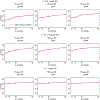An improved method for bivariate meta-analysis when within-study correlations are unknown
- PMID:29055096
- PMCID: PMC6071677
- DOI: 10.1002/jrsm.1274
An improved method for bivariate meta-analysis when within-study correlations are unknown
Abstract
Multivariate meta-analysis, which jointly analyzes multiple and possibly correlated outcomes in a single analysis, is becoming increasingly popular in recent years. An attractive feature of the multivariate meta-analysis is its ability to account for the dependence between multiple estimates from the same study. However, standard inference procedures for multivariate meta-analysis require the knowledge of within-study correlations, which are usually unavailable. This limits standard inference approaches in practice. Riley et al proposed a working model and an overall synthesis correlation parameter to account for the marginal correlation between outcomes, where the only data needed are those required for a separate univariate random-effects meta-analysis. As within-study correlations are not required, the Riley method is applicable to a wide variety of evidence synthesis situations. However, the standard variance estimator of the Riley method is not entirely correct under many important settings. As a consequence, the coverage of a function of pooled estimates may not reach the nominal level even when the number of studies in the multivariate meta-analysis is large. In this paper, we improve the Riley method by proposing a robust variance estimator, which is asymptotically correct even when the model is misspecified (ie, when the likelihood function is incorrect). Simulation studies of a bivariate meta-analysis, in a variety of settings, show a function of pooled estimates has improved performance when using the proposed robust variance estimator. In terms of individual pooled estimates themselves, the standard variance estimator and robust variance estimator give similar results to the original method, with appropriate coverage. The proposed robust variance estimator performs well when the number of studies is relatively large. Therefore, we recommend the use of the robust method for meta-analyses with a relatively large number of studies (eg, m≥50). When the sample size is relatively small, we recommend the use of the robust method under the working independence assumption. We illustrate the proposed method through 2 meta-analyses.
Keywords: correlation; multivariate meta-analysis; random effects; robust variance estimator.
Copyright © 2017 John Wiley & Sons, Ltd.
Figures






Similar articles
- An alternative model for bivariate random-effects meta-analysis when the within-study correlations are unknown.Riley RD, Thompson JR, Abrams KR.Riley RD, et al.Biostatistics. 2008 Jan;9(1):172-86. doi: 10.1093/biostatistics/kxm023. Epub 2007 Jul 11.Biostatistics. 2008.PMID:17626226
- A generalized-weights solution to sample overlap in meta-analysis.Bom PRD, Rachinger H.Bom PRD, et al.Res Synth Methods. 2020 Nov;11(6):812-832. doi: 10.1002/jrsm.1441. Epub 2020 Sep 18.Res Synth Methods. 2020.PMID:32790019
- A method of moments estimator for random effect multivariate meta-analysis.Chen H, Manning AK, Dupuis J.Chen H, et al.Biometrics. 2012 Dec;68(4):1278-84. doi: 10.1111/j.1541-0420.2012.01761.x. Epub 2012 May 2.Biometrics. 2012.PMID:22551393Free PMC article.
- An Empirical Assessment of Bivariate Methods for Meta-Analysis of Test Accuracy [Internet].Dahabreh IJ, Trikalinos TA, Lau J, Schmid C.Dahabreh IJ, et al.Rockville (MD): Agency for Healthcare Research and Quality (US); 2012 Nov. Report No.: 12(13)-EHC136-EF.Rockville (MD): Agency for Healthcare Research and Quality (US); 2012 Nov. Report No.: 12(13)-EHC136-EF.PMID:23326899Free Books & Documents.Review.
- Random-effects models for meta-analytic structural equation modeling: review, issues, and illustrations.Cheung MW, Cheung SF.Cheung MW, et al.Res Synth Methods. 2016 Jun;7(2):140-55. doi: 10.1002/jrsm.1166.Res Synth Methods. 2016.PMID:27286900Review.
Cited by
- Random-effects meta-analysis of combined outcomes based on reconstructions of individual patient data.Song Y, Sun F, Redline S, Wang R.Song Y, et al.Res Synth Methods. 2020 Sep;11(5):594-616. doi: 10.1002/jrsm.1406. Epub 2020 May 8.Res Synth Methods. 2020.PMID:32270909Free PMC article.
- Multivariate meta-analysis of critical care meta-analyses: a meta-epidemiological study.Moran JL.Moran JL.BMC Med Res Methodol. 2021 Jul 18;21(1):148. doi: 10.1186/s12874-021-01336-4.BMC Med Res Methodol. 2021.PMID:34275460Free PMC article.
- Classifying information-sharing methods.Nikolaidis GF, Woods B, Palmer S, Soares MO.Nikolaidis GF, et al.BMC Med Res Methodol. 2021 May 22;21(1):107. doi: 10.1186/s12874-021-01292-z.BMC Med Res Methodol. 2021.PMID:34022810Free PMC article.
References
- Baker Rose, & Jackson Dan. 2008. A new approach to outliers in meta-analysis. Health care management science, 11(2), 121–131. - PubMed
- Bénard Jean, Raguénez Gilda, Kauffmann Audrey, Valent Alexander, Ripoche Hugues, Joulin Virginie, Job Bastien, Danglot Giséle, Cantais Sabrina, Robert Thomas, et al. . 2008. Mycn-non-amplified metastatic neuroblastoma with good prognosis and spontaneous regression: a molecular portrait of stage 4s. Molecular oncology, 2(3), 261–271. - PMC - PubMed
- Berkey CS, Antczak-Bouckoms A, Hoaglin DC, Mosteller E, & Pihlstrom BL. 1995. Multiple-outcomes meta-analysis of treatments for periodontal disease. Journal of dental research, 74(4), 1030–1039. - PubMed
- Borenstein M, Hedges LV, Higgins JPT, & Rothstein HR 2009. Introductionto meta-analysis. Wiley Online Library.
MeSH terms
Substances
Grants and funding
LinkOut - more resources
Full Text Sources
Other Literature Sources
Medical
Research Materials
